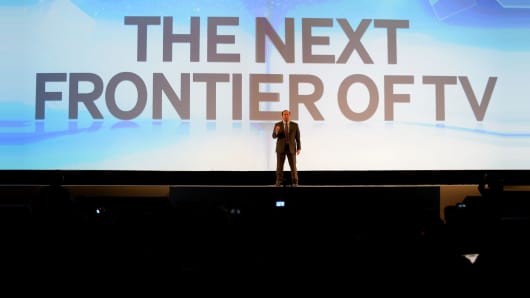Cord Nevers are exactly what they sound like: kids who move out on their own but never pay for a monthly TV service. They're used to streaming on their smart phones and laptops, and they're not intimidated by what it takes to get apps on their Internet-connected TVs. And now their ranks could be fueled by many of the services making news here at CES: they're designed to help people watch video on their flat screens without that monthly cable bill.
Aereo kicked off CES with news that it's expanding its access to live and recorded TV for as low as $8 a month nationwide. After starting off in the New York region over the course of the last year, it plans to launch in 22 markets, becoming accessible to 97 million consumers by the end of 2013.
The company can offer television access inexpensively because it's based on a controversial technology: it owns a minuscule antenna for each customer, enabling it to broadcast TV without paying re-transmission fees to media companies. (Litigation from media companies is ongoing).
CEO Chet Kanoja is entirely upfront about the fact that he is going after the young "cord never" demographic. He says half of Aereo's subscribers have never paid for cable. "You know anyone under the age of 30 isn't going to go out and get a cable subscription," Kanoja said. "So they represent a massive audience and the opportunity to create a completely new ecosystem."
Other companies with new products here at CES are appealing to the same demographic, but without the same overt attack on the status quo.
Google's YouTube showcased a new app that's designed to make it easier to watch YouTube videos on a TV set. The app allows users to search for video -- and create a video queue-- on a smart phone. A tap on the screen sends the video to the TV set. And it's not just skateboarding bulldogs; YouTube has been pouring funding into professionally-generated content made for the web, from everyone from Ashton Kutcher to Amy Poehler.
Google had been testing this app with Google TVs, but its latest announcement brings this app to all the major TV-makers.
So just how big a threat are "cord nevers" to the traditional media business? It's very tough to count the number of people who have never signed up for something. The sheer number of people who pay for some sort of television service -- from a cable, telecom, or satellite TV company -- is holding strong.
But media research firm SNL Kagan sees a rise of 'cord nevers' in the fact that a declining percentage of American households are paying for TV.
SNL Kagan analyst Ian Olgeirson noted that 85 percent of American households paid for TV service in the third quarter of 2012, down from 87 percent penetration in the third quarter of 2009. SNL Kagan estimates that 4.3 million people relied on Internet video instead of paying for TV, projecting that number will more than double by 2016.
How fast the ranks of 'cord nevers' grows depends on a couple factors -- how easy and high-quality the content options are that don't require paying for TV, and how much the traditional distributors do to make their subscriptions worthwhile. This is the battle that's playing out in the announcements here at CES -- the stakes are high and driving innovation.



